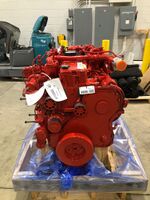IIWiki:Today's featured article: Difference between revisions
(July 2024 Update) |
(August 2024 Update) |
||
| Line 1: | Line 1: | ||
<div style="float:left;margin:0.5em 0.9em 0.4em 0;">[[File: | <div style="float:left;margin:0.5em 0.9em 0.4em 0;">[[File:Dieselengine.jpg|150px]]</div> The '''Nagumo F-series engine''' is a straight-six diesel engine designed and produced by Nagumo Heavy Industries Powertrain Division in [[Jin Yi]]. It displaces 10.5litres and began production in 1991 as the NSL and NSLD (defense) at Nagumo Powertrain Plant 5 in Fushou. The F-series engine is a road going version of the larger Nagumo E-series engine, which is typically utilized for heavy industrial use in {{wp|generators}}, {{wp|mining equipment}} and other heavy duty functions. The F-series is widely utilized in [[Jin Yi]] for heavy and medium duty applications such as buses, trucks, and other vehicles. The F-series production D is used specifically for defense applications and continually developed. The F-series engines are available with multiple emissions packages to fulfill emissions requirements in various nation but the most common is the Schedule C emissions control package, which is required for certain areas of Jin Yi. In 2014, Nagumo announced the release of the FSLH engine powered by a hydrogen fuel cell on the same F-series architecture and currently offers four different power tunes for these engines. ('''[[Nagumo F-series engine|See more...]]''') | ||
<div align="right"> | <div align="right"> | ||
Revision as of 01:09, 7 August 2024
The Nagumo F-series engine is a straight-six diesel engine designed and produced by Nagumo Heavy Industries Powertrain Division in Jin Yi. It displaces 10.5litres and began production in 1991 as the NSL and NSLD (defense) at Nagumo Powertrain Plant 5 in Fushou. The F-series engine is a road going version of the larger Nagumo E-series engine, which is typically utilized for heavy industrial use in generators, mining equipment and other heavy duty functions. The F-series is widely utilized in Jin Yi for heavy and medium duty applications such as buses, trucks, and other vehicles. The F-series production D is used specifically for defense applications and continually developed. The F-series engines are available with multiple emissions packages to fulfill emissions requirements in various nation but the most common is the Schedule C emissions control package, which is required for certain areas of Jin Yi. In 2014, Nagumo announced the release of the FSLH engine powered by a hydrogen fuel cell on the same F-series architecture and currently offers four different power tunes for these engines. (See more...)
KEEP THIS ONE PARAGRAPH IN LENGTH so it doesn't push the main page section down below the other section.
